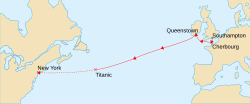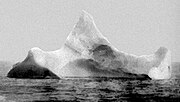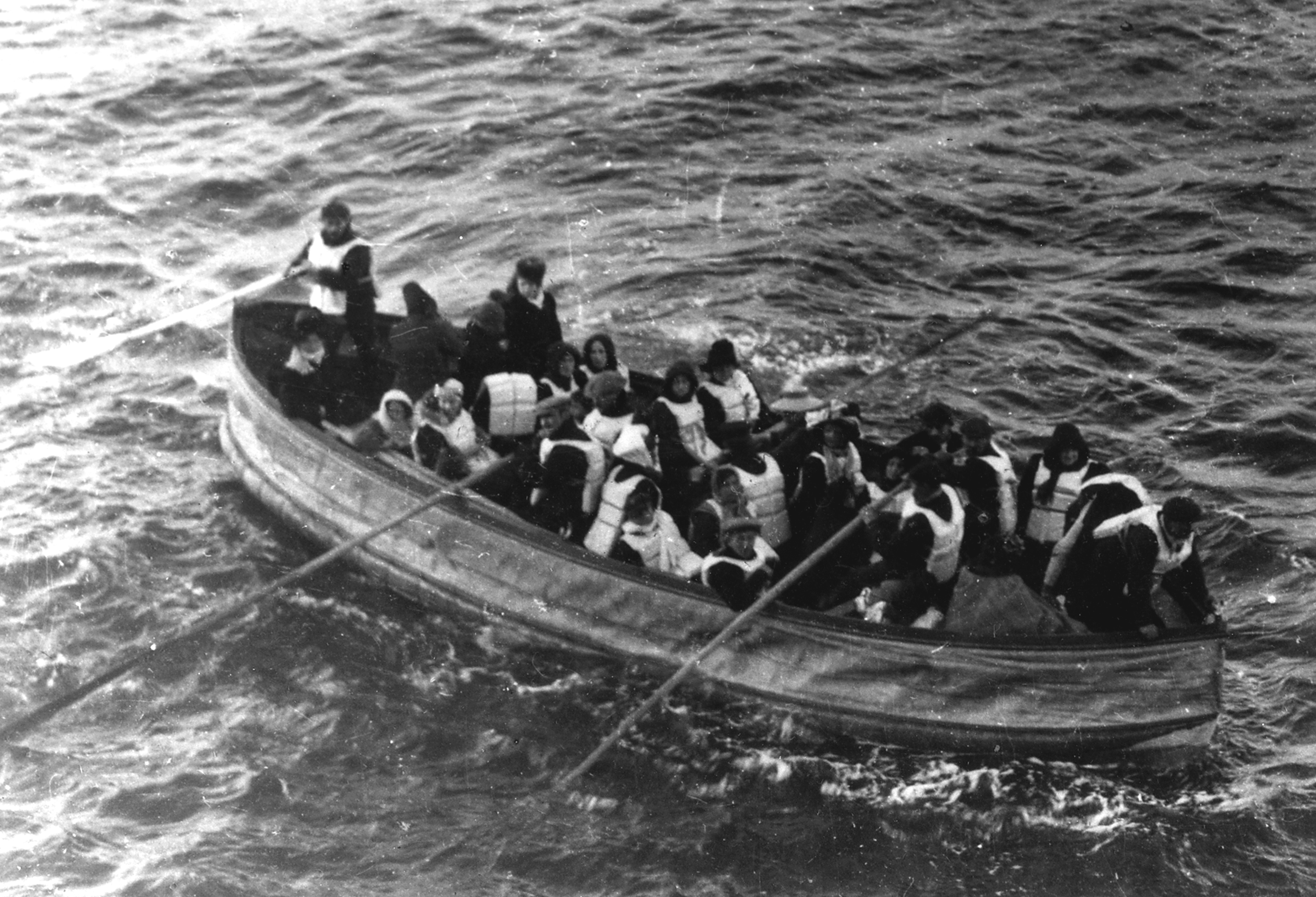Sea trials
Titanic's sea trials took place shortly after after she was fitted out at Harland & Wolff shipyard. The trials were originally scheduled for 10.00am on Monday, 1 April, just 9 days before she was due to leave Southampton on her maiden voyage, but poor weather conditions forced the trials to be postponed until the following day. Aboard Titanic were 78 stokers, greasers and firemen, and 41 members of crew. No domestic staff appear to have been aboard. Representatives of various companies travelled on Titanic's sea trials, including Harold A. Sanderson of I.M.M and Thomas Andrews and Edward Wilding of Harland and Wolff. Bruce Ismay and Lord Pirrie were too ill to attend. Jack Phillips and Harold Bride served as radio operators, and performed fine-tuning of the Marconi equipment. Mr Carruthers, a surveyor from the Board of Trade, was also present to see that everything worked, and that the ship was fit to carry passengers. After the trial, he signed an 'Agreement and Account of Voyages and Crew', valid for twelve months, which deemed the ship sea-worthy.[20]
Maiden voyage

The vessel began her maiden voyage from Southampton, England, bound for New York City, New York, on Wednesday, 10 April 1912, with Captain Edward J. Smith in command. As the Titanic left her berth, her wake caused the liner City of New York, which was docked nearby, to break away from her moorings, whereupon she was drawn dangerously close (about four feet) to the Titanic before a tugboat towed the New York away.[21] The incident delayed departure for one hour[citation needed]. After crossing the English Channel, the Titanic stopped at Cherbourg, France, to board additional passengers and stopped again the next day at Queenstown (known today as Cobh), Ireland. As harbour facilities at Queenstown were inadequate for a ship of her size, Titanic had to anchor off-shore, with small boats, known as tenders, ferrying the embarking passengers out to her. When she finally set out for New York, there were 2,240 people aboard.[22]
John Coffey, a 23-year-old crewmember, jumped ship by stowing away on a tender and hid amongst mailbags headed for Queenstown. Coffey stated that the reason for smuggling himself off the liner was that he held a superstition about sailing and specifically about travelling on the Titanic. However, he later signed on to join the crew of the Mauretania.[23]

On the maiden voyage of the Titanic some of the most prominent people of the day were travelling in first–class. Some of these included millionaire John Jacob Astor IV and his wife Madeleine Force Astor, industrialist Benjamin Guggenheim, Macy's owner Isidor Straus and his wife Ida, Denver millionairess Margaret "Molly" Brown, Sir Cosmo Duff Gordon and his wife couturière Lucy (Lady Duff-Gordon), George Elkins Widener and his wife Eleanor; cricketer and businessman John Borland Thayer with his wife Marian and their seventeen-year-old son Jack, journalist William Thomas Stead, the Countess of Rothes, United States presidential aide Archibald Butt, author and socialite Helen Churchill Candee, author Jacques Futrelle his wife May and their friends, Broadway producers Henry and Rene Harris and silent film actress Dorothy Gibson among others.[24] Also travelling in first–class were White Star Line's managing director J. Bruce Ismay and the ship's builder Thomas Andrews, who was on board to observe any problems and assess the general performance of the new ship.[24]
Sinking
On the night of Sunday, 14 April 1912, the temperature had dropped to near freezing and the ocean was calm. The moon was not visible and the sky was clear. Captain Smith, in response to iceberg warnings received via wireless over the preceding few days, altered the Titanic's course slightly to the south. That Sunday at 13:45,[a] a message from the steamer Amerika warned that large icebergs lay in the Titanic's path, but as Jack Phillips and Harold Bride, the Marconi wireless radio operators, were employed by Marconi [25] and paid to relay messages to and from the passengers,[26] they were not focused on relaying such "non-essential" ice messages to the bridge.[27] Later that evening, another report of numerous large icebergs, this time from the Mesaba, also failed to reach the bridge.
At 23:40, while sailing about 400 miles south of the Grand Banks of Newfoundland, lookouts Fredrick Fleet and Reginald Lee spotted a large iceberg directly ahead of the ship. Fleet sounded the ship's bell three times and telephoned the bridge exclaiming, "Iceberg, right ahead!". First Officer Murdoch gave the order "hard-a-starboard", using the traditional tiller order for an abrupt turn to port (left), and the engines to be put in full reverse (although a survivor from the engine room testified that, as he recalled, the indicator of the telegraph had moved to "stop", and only after the impact).[28][29] A collision was inevitable and the iceberg brushed the ship's starboard side (right side), buckling the hull in several places and popping out rivets below the waterline over a length of 299 feet (90 m). As seawater filled the forward compartments, the watertight doors shut. However, while the ship could stay afloat with four flooded compartments, five were filling with water. The five water-filled compartments weighed down the ship so that the tops of the forward watertight bulkheads fell below the ship's waterline, allowing water to pour into additional compartments. Captain Smith, alerted by the jolt of the impact, arrived on the bridge and ordered a full stop. Shortly after midnight on 15 April, following an inspection by the ship's officers and Thomas Andrews, the lifeboats were ordered to be readied and a distress call was sent out.
Wireless operators Jack Phillips and Harold Bride were busy sending out CQD, the international distress signal. Several ships responded, including Mount Temple, Frankfurt and Titanic's sister ship, Olympic, but none was close enough to make it in time.[30] The closest ship to respond was Cunard Line's Carpathia 58 miles (93 km) away, which could arrive in an estimated four hours—too late to rescue all of Titanic's passengers. The only land–based location that received the distress call from Titanic was a wireless station at Cape Race, Newfoundland.[30]
From the bridge, the lights of a nearby ship could be seen off the port side. The identity of this ship remains a mystery but there have been theories suggesting that it was probably either the Californian or a sealer called the Sampson.[31] As it was not responding to wireless, Fourth Officer Boxhall and Quartermaster Rowe attempted signalling the ship with a Morse lamp and later with distress rockets, but the ship never appeared to respond.[32] The Californian, which was nearby and stopped for the night because of ice, also saw lights in the distance. The Californian's wireless was turned off, and the wireless operator had gone to bed for the night. Just before he went to bed at around 23:00 the Californian's radio operator attempted to warn the Titanic that there was ice ahead, but he was cut off by an exhausted Jack Phillips, who had fired back an angry response, "Shut up, shut up, I am busy; I am working Cape Race", referring to the Newfoundland wireless station. [33] When the Californian's officers first saw the ship, they tried signalling her with their Morse lamp, but also never appeared to receive a response. Later, they noticed the Titanic's distress signals over the lights and informed Captain Stanley Lord. Even though there was much discussion about the mysterious ship, which to the officers on duty appeared to be moving away, the Californian did not wake her wireless operator until morning.[32]
Lifeboats launched

The first lifeboat launched was Lifeboat 7 on the starboard side with 28 people on board out of a capacity of 65. It was lowered at around 00:40 as believed by the British Inquiry.[34][35] Lifeboat 5 and Lifeboat 6 were launched ten minutes later. The Titanic carried 20 lifeboats with a total capacity of 1,178 people. While not enough to hold all of the passengers and crew, the Titanic carried more boats than was required by the British Board of Trade Regulations. At the time, the number of lifeboats required was determined by a ship's gross register tonnage, rather than her human capacity.
The Titanic showed no outward signs of being in imminent danger, and passengers were reluctant to leave the apparent safety of the ship to board small lifeboats. As a result, most of the boats were launched partially empty; one boat meant to hold 40 people left the Titanic with only 12 people on board it. With "Women and children first" the imperative for loading lifeboats, Second Officer Lightoller, who was loading boats on the port side, allowed men to board only if oarsmen were needed, even if there was room. First Officer Murdoch, who was loading boats on the starboard side, let men on board if women were absent. As the ship's list increased people started to become nervous, and some lifeboats began leaving fully loaded. By 02:05, the entire bow was under water, and all the lifeboats, save for two, had been launched.
Final minutes
Around 02:10, the stern rose out of the water exposing the propellers, and by 02:17 the waterline had reached the boat deck. The last two lifeboats floated off the deck, one upside down, the other half-filled with water. Shortly afterwards, the forward funnel collapsed, crushing part of the bridge and people in the water. On deck, people were scrambling towards the stern or jumping overboard in hopes of reaching a lifeboat. The ship's stern slowly rose into the air, and everything unsecured crashed towards the water. While the stern rose, the electrical system finally failed and the lights went out. Shortly afterwards, the stress on the hull caused Titanic to break apart between the last two funnels, and the bow went completely under. The stern righted itself slightly and then rose vertically. After a few moments, at 02:20, this too sank into the ocean.
Only two of the 18 launched lifeboats rescued people after the ship sank. Lifeboat 4 was close by and picked up five people, two of whom later died. Close to an hour later, lifeboat 14 went back and rescued four people, one of whom died afterwards. Other people managed to climb onto the lifeboats that floated off the deck. There were some arguments in some of the other lifeboats about going back, but many survivors were afraid of being swamped by people trying to climb into the lifeboat or being pulled down by the suction from the sinking Titanic, though it turned out that there had been very little suction.
As the ship fell into the depths, the two sections behaved very differently. The streamlined bow planed off approximately 2,000 feet (609 m) below the surface and slowed somewhat, landing relatively gently. The stern plunged violently to the ocean floor, the hull being torn apart along the way from massive implosions caused by compression of the air still trapped inside. The stern smashed into the bottom at considerable speed, grinding the hull deep into the silt.
After steaming under a forced draft for just under four hours, the RMS Carpathia arrived in the area and at 04:10 began rescuing survivors. By 08:30 she picked up the last lifeboat with survivors and left the area at 08:50 bound for New York.[36]






0 comments:
Post a Comment